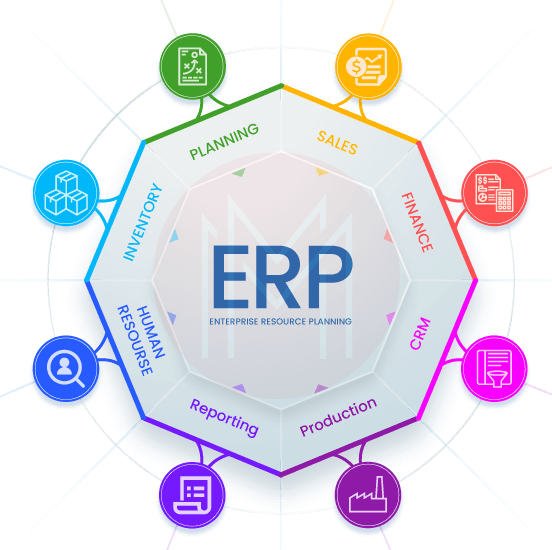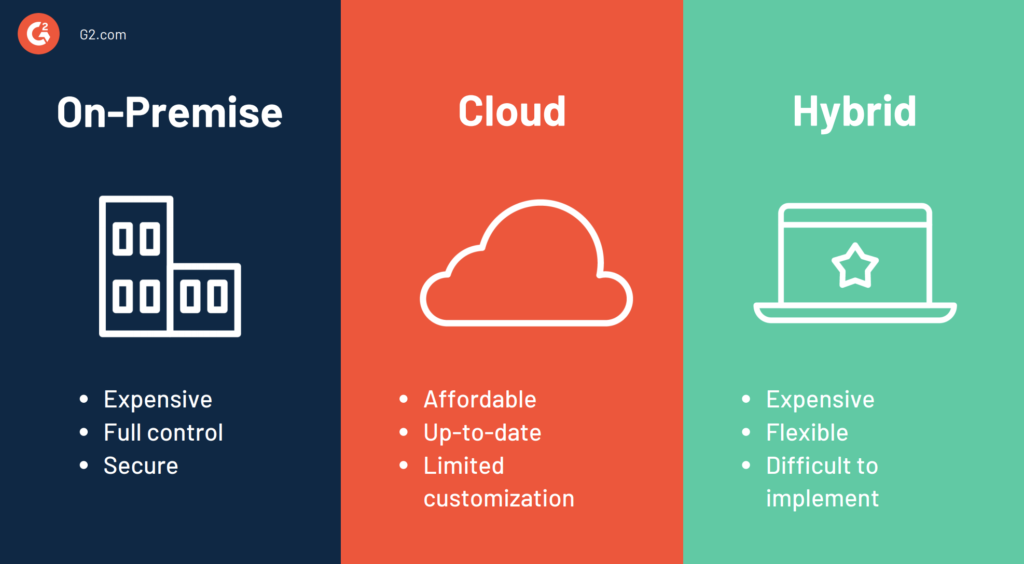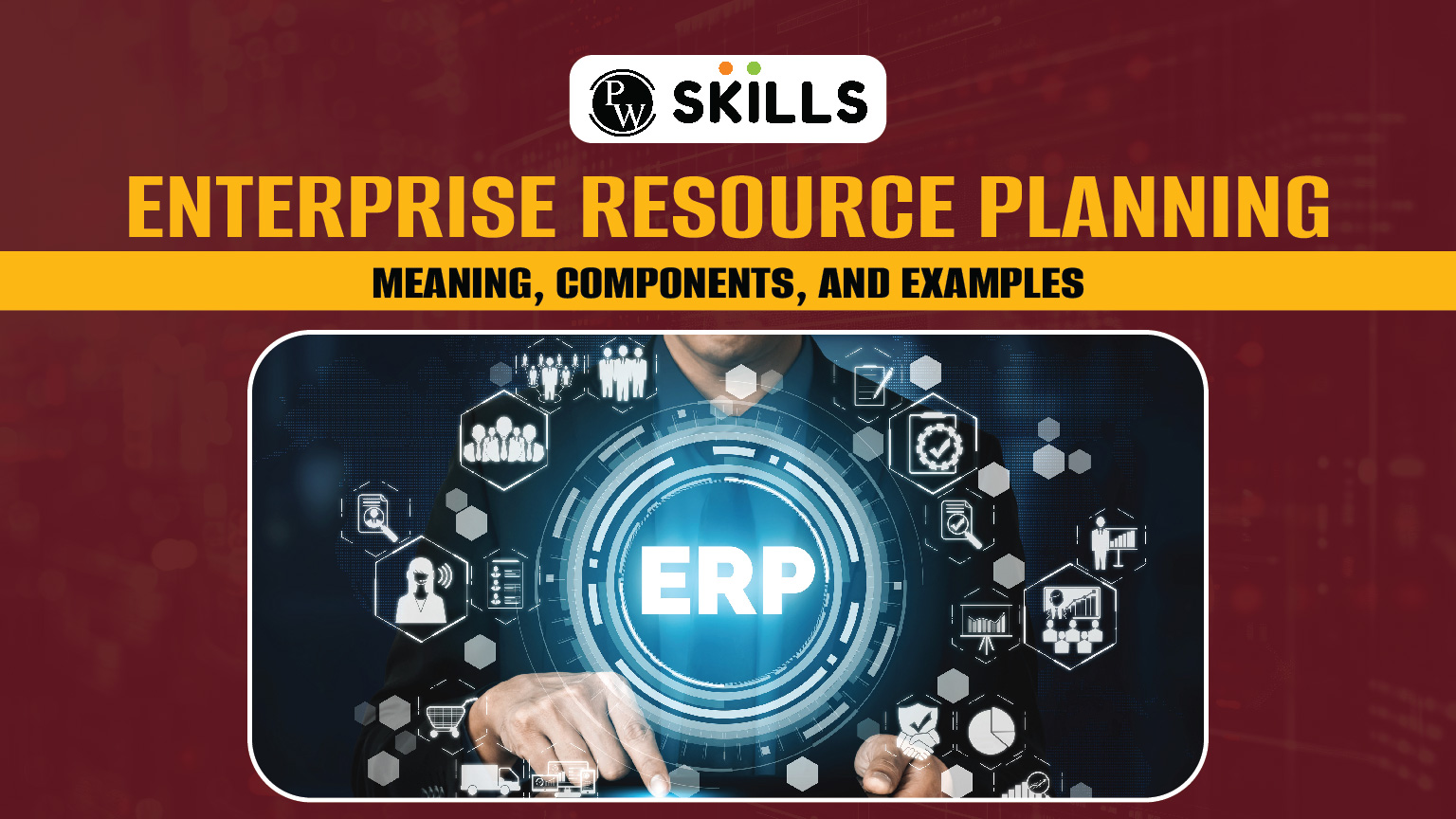As companies are expanding rapidly, spreadsheets often become inefficient for managing their daily tasks. This is where enterprise resource planning (ERP) software comes into action. ERP systems gather and organize important business information, allowing companies to operate smoothly and efficiently, even as they expand. While many people in business have heard of ERP, they may not fully understand how these systems can benefit their teams.
Let us read this article to understand what Enterprise resource planning is, what are the types of enterprise resource planning, what are ERP tools, and much more. So, let us read further and understand everything clearly.
Enterprise Resource Planning – Key Takeaways
- Enterprise Resource Planning software integrates and manages key business functions such as finance, inventory, sales, and human resources in one centralized system, improving efficiency and reducing errors.
- ERP systems come in various types including On-Premise, Cloud, Industry-Specific, Open-Source, Small Business, and Tiered ERP, each catering to different business needs and sizes.
- ERP systems enhance accuracy and productivity, improve real-time reporting, increase operational efficiency, and promote better interdepartmental collaboration.
- When selecting an ERP software, consider factors like scalability, customization, integration, user-friendliness, mobile access, security, analytics, support, and total cost. Popular ERP tools include NetSuite, SAP ERP, and FreshBooks, each with unique features and pricing options.

What Is An Enterprise Resource Planning?
Enterprise Resource Planning (ERP) is a software system that businesses use to manage and integrate important parts of their operations. ERP software is very important for companies because it helps them to plan and organize resources by bringing together all the processes they need into one system.
With Enterprise Resource Planning software, businesses can combine tasks like planning, buying inventory, sales, marketing, finance, and human resources in one place.
For example, a retail company might use ERP to track its inventory, manage employee schedules, handle finances, and monitor sales. This makes everything easier to manage, saves time, and reduces mistakes by keeping all information in one system.
Understanding Enterprise Resource Planning In A Better Way
An Enterprise Resource Planning (ERP) system acts like a central hub that connects different computer systems in a large organization. Without ERP software, each department would use its own system for its specific tasks. But with the introduction of Enterprise Resource Planning, all these systems are linked through one application with a single interface.
Enterprise Resource Planning systems help departments to communicate and share information more easily. They collect data from different parts of the company, making it available across the organization so it can be used effectively.
By connecting information about production, finance, distribution, and human resources, ERP systems make a company more aware of its operations. They also help in avoiding problems with duplicate and incompatible technologies.
Types Of Enterprise Resource Planning
There are many different types of Enterprise Resource Planning (ERP) systems that can help businesses in managing their operations efficiently. Here is a simple overview of some of the main types:

1. On-Premise ERP
This type of ERP system is installed on a company’s own servers. The company buys the software and manages everything themselves. They have full control over their data and system, but it requires a dedicated IT team to handle the maintenance, updates, and security of this system.
2. Cloud ERP
Cloud ERP systems are hosted on remote servers and are accessed online. They are usually sold as subscription services. This type of ERP is easy to scale up or down based on business needs and does not require a large upfront investment in hardware. The provider takes care of updates and maintenance which can significantly save the company’s expenditure cost.
3. Industry-Specific ERP
These ERP systems are designed for specific industries, like manufacturing or finance. They come with features and modules tailored to the unique needs of that industry.
For example, a manufacturing ERP will focus on inventory and supply chain management, while a financial ERP will cater to banking and financial operations.
4. Open-Source ERP
An open-source ERP system gives users access to the source code, this means that the companies can change, customize, or share the software to fit their needs. However, using open-source ERP systems may require more technical skills and resources compared to ready-made ERP solutions.
5. Small Business ERP
Small business ERP systems are created for the specific needs of small and medium-sized businesses (SMBs). These systems provide essential features at a lower cost and are easier to set up. Since they are not as complex as larger systems, they often need less customization and are quicker to implement.
6. Tiered ERP
Tiered ERP systems offer different levels of features to match the needs of businesses of various sizes. Companies can start with a basic tier and add more features as they grow. For example, a company might wait to add a module for international currency until it starts operating globally.
How Enterprise Resource Planning Platforms Work
Enterprise Resource Planning has changed and evolved a lot over time. It was first started as a traditional software that used physical servers and manual data entry. But now, it has become cloud-based software that can be accessed remotely through the web. The company that created the software usually maintains the platform, and businesses rent these services instead of owning them.
From the plenty of applications available over the internet, companies choose the applications that provide the best services according to their needs, and the service provider sets them up on the server the company is renting.
Then, both the business and the service provider work together to connect the company’s processes and data to the system.
Once all departments are connected to the platform, the data from each department is stored on the server and can be accessed by those with permission. This makes it easy to generate reports with charts, graphs, or other tools, helping the business to see how its different departments are doing.
Benefits of Enterprise Resource Planning
Businesses use enterprise resource planning (ERP) systems for various reasons, such as growth, cost reduction, and improving operations. While the specific benefits may vary between companies, some common benefits of Enterprise Resource Planning are:
1. Boosts Accuracy and Productivity
ERP systems helps in automating and connecting different business processes. This removes repetitive tasks and improves accuracy. When departments work together through an ERP, they can coordinate their tasks better, leading to quicker and more effective results.
2. Improves Reporting
Many businesses get benefit from better real-time data reporting through a unified system. With accurate and complete reports, companies can plan, budget, and forecast more effectively. This also helps them to share important information with the organization and other stakeholders in an efficient manner.
3. Increases Efficiency
ERP systems make it easier for businesses to quickly find information related to clients, vendors, or partners. This improves customer and employee satisfaction, speeds up response times, and increases accuracy. As a result, operating costs often decrease because the business runs more efficiently.
4. Enhances Collaboration
ERP systems help departments collaborate more easily and share information. When teams work together, overall productivity increases, and employees feel more satisfied as they see how their roles fit into the company’s goals. Also, tedious tasks are automated, allowing employees to focus on more meaningful work.
ERP Vs CRM
Many people often get confused by thinking ERP and CRM as similar terms, but in reality, they are not. Both of them are quite different from each other and are used for different roles. Let us understand their basic difference with the help of the table below:
| ERP Vs CRM | |
| ERP (Enterprise Resource Planning) | CRM (Customer Relationship Management) |
| Their main focus is on managing and integrating core business processes (finance, inventory, etc.) | Their focus is on managing customer relationships, sales, and marketing activities |
| Their key functions involve handling finance, supply chain, inventory, HR, and manufacturing | CRM Software main focuses is on sales, customer service, marketing, and lead management |
| Their main objective is to streamline internal business operations | The objective here is to improve customer relationships and drive sales growth |
| ERP is used by various departments: finance, HR, procurement, supply chain | It is primarily used by sales, marketing, and customer service teams |
| ERP has a broader scope, covering multiple business functions | It has a narrower scope as compared to ERP, focused mainly on customer interaction management |
| ERP generally has higher cost compared to CRM, due to its broader implementation | It has lower cost as it is focused on customer management |
Tips To Choose Enterprise Resource Planning System
When choosing an Enterprise Resource Planning system, there are several important things to keep in mind. Here are the key features to consider during the decision process:
- Scalability: Make sure the ERP software system can grow with your business. It should handle more transactions, users, and data as your business expands, without causing performance problems.
- Customization: Look for an ERP software that allows you to customize it to fit your business needs. You should be able to modify workflows, fields, forms, and reports to suit your specific processes.
- Integration: The Enterprise resource planning software should easily connect with other software you already use, like your CRM, payroll, or e-commerce platforms. This will help your business tools to work together smoothly.
- User-Friendly Interface: Choose an ERP software with a simple and easy-to-use interface. This makes it easier for your team to learn and use the system effectively, ensuring that they get the most out of it.
- Mobile Access: If your business requires flexibility, consider Enterprise Resource Planning software that can be accessed on mobile devices. This allows you to check information and make decisions on the go.
- Security and Compliance: Maintaining data security is critical. Make sure the ERP software has strong security features like encryption, access controls, and audit trails to protect your business data. It should also meet any specific security standards relevant to your industry.
- Analytics and Reporting: A good ERP software should have built-in reporting and analytics tools. This helps you access real-time data and create reports, which are important for making informed decisions.
- Support and Maintenance: Consider the level of support provided by the ERP vendor. You will need help with technical issues, software updates, and training, so it is important to choose a system with good customer support.
- Total Cost: Lastly, it is important to think about the total cost of the ERP system. Don’t just consider the initial price but also the factor in ongoing maintenance, training, and potential extra costs, like adding more features as your business grows.
Top ERP Tools To Consider In 2024
In today’s time, you must have noticed plenty of ERP tools available on the internet each providing different features and catering to different business needs. But in this plenty of ERP tools available over the internet there are some tools that stand out in the market due to their unique holistic features and pricing options, let us lear more about them in brief:
1. NetSuite
NetSuite is a popular cloud-based ERP software used by over 37,000 companies worldwide. It helps companies to simplify business operations by automating key tasks and providing real-time insights into financial and operational data.
NetSuite also integrates well with most FP&A and budgeting tools, allowing users to easily pull data into spreadsheets for financial planning. Due to its popularity, it connects with hundreds of other software tools.
Pricing: Pricing for the NetSuite ERP tool is based on custom quotes, as it depends on the core platform, additional modules, and the number of users. There is also a one-time fee for setting up the software. However, it also provides a free demo and trial session for interested businesses.
2. SAP ERP Tools
SAP Business One is a well-known ERP software for small and medium-sized businesses. It helps companies to manage finances, customer relationships, inventory, and sales all in one place.
With SAP ERP, companies can track and analyze their business in real time, making it easier to plan and forecast finances. It is one of the best ERP tools for businesses already using SAP products and those familiar with data science.
Pricing: SAP ERP offers a yearly license plan of $3,213. In addition to this, there are also yearly maintenance charges that every business has to pay. However, there is a facility of on-request free trial to gain hands-on-experience.
3. Freshbook
FreshBooks is one of the online accounting ERP tools designed for freelancers, professionals, and small businesses. It helps you to automate invoicing, bookkeeping, and time-tracking tasks.
With FreshBooks, you can easily send invoices, manage payments, and track time all in one place. It also supports card payments and sends reminders for late payments. Key features include expense tracking, invoicing, reports, and time tracking.
Pricing: Talking about the pricing of this ERP software, it offers 30-day free trial sessions for new user and comes up with the four different pricing options.
- Lite: $7.60/month (Up to 5 billable clients)
- Plus: $13.20/month (Up to 50 billable clients)
- Premium: $24/month (Unlimited billable clients)
- Custom pricing is also available for specific business needs.
Learn ERP With PW Skills
Enroll In our comprehensive PW Skills product management with AI course to learn all the essential concepts and tools required to become a proficient product manager.
This 6-month-long product manager course is designed to help beginners as well as professionals to learn all the concepts and tools related to product management in a beginner-friendly manner. Starting from the foundational concepts and slowly moving to the advanced ones.
Visit PWskills.com to explore more about course offerings and grab your seat today.
Recommended Courses
Enterprise Resource Planning FAQs
What should a business consider when choosing an ERP system?
Businesses should consider factors like scalability, customization, integration with existing software, user-friendliness, mobile access, security, support, and the total cost of the ERP system while going for any ERP software.
How do ERP systems help with business growth?
ERP systems support business growth by providing scalable solutions that can handle increased transactions, users, and data. In addition to this, they also help in improving overall operational efficiency and decision-making by providing unified view of data across the organization.
What are some popular ERP tools available in 2024?
Popular ERP tools include NetSuite, SAP ERP, and FreshBooks, each offering different features and pricing options to cater to various business needs and sizes.
What is the difference between ERP and CRM?
ERP focuses on managing and integrating core business processes like finance and supply chain, while CRM (Customer Relationship Management) focuses on managing customer relationships, sales, and marketing activities.

